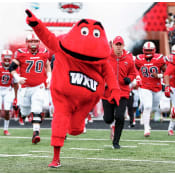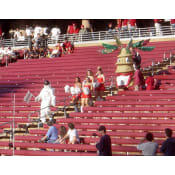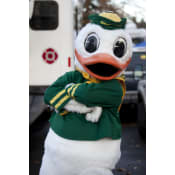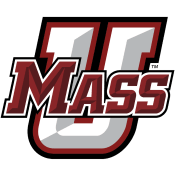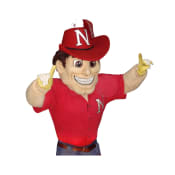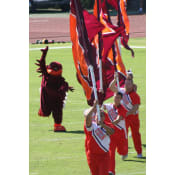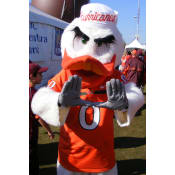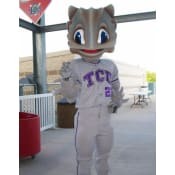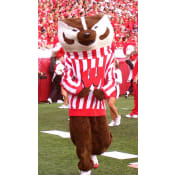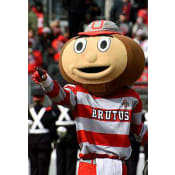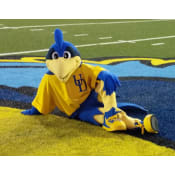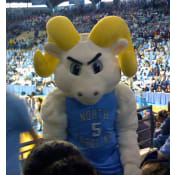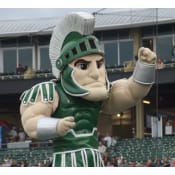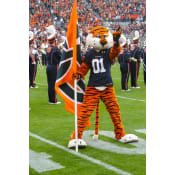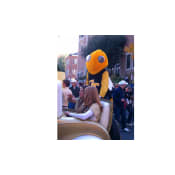Who Has the Best College Football Mascots?
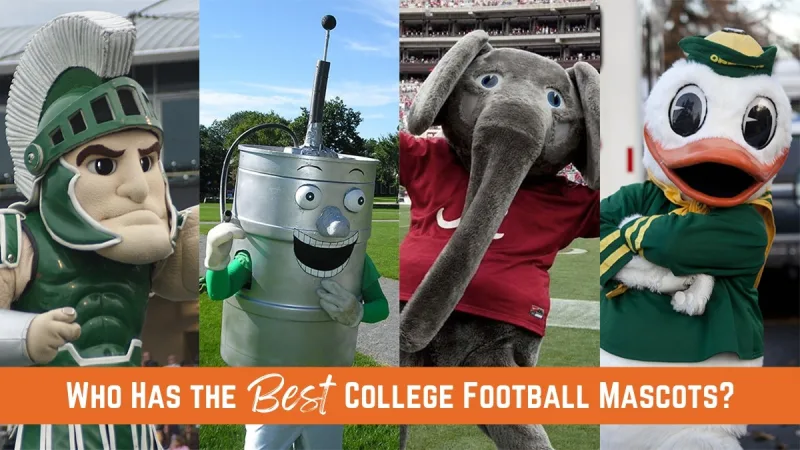
Is there anything more important than the school mascot when it comes to choosing your college? Yes. There are at least a hundred things that are way more important. But there are few things that are more fun. Your college mascot is not just an acrobatic weirdo with crazy eyes and a terrifying perma-smile. It’s so much more than that—it is the embodiment of your school, its fighting spirit, and its identity.
Key Takeaways
- A college football mascot is not just for display. Schools believe that mascots embody their school’s fighting spirit and identity, bringing them luck.
- The role of college mascots is taken very seriously. Not all students get to be one!
- Mascots add some entertainment value to collegiate sports, especially for people who have no interest in watching any college games.
If your school has a vaunted football program, your mascot can be a lightning rod, helping to channel the electric energy of your home crowd. If your school’s team is lousy, at the least the mascot is something to watch. Either way, mascots rule. So in celebration of the college Bowl Game season, we’re highlighting the weird, wild, and wonderful work of these strange creatures.
But first...
Football: A Long-running College Sport
Due to traditions, college football season usually starts on the Thursday before Labor Day and ends the first Saturday in December. For many college students, football season is the most awaited time of the year. Pure entertainment is the major factor behind American college football’s immense popularity.
America’s passion for college sports is fueled by its history, rivalries, competitions, and sports betting. More importantly, this is when students get to see the coolest mascots steal the spotlight in the football games.
Mascots make college sports a little more entertaining, especially for those who aren’t particularly interested in watching, and some of the best mascot moments include dance-offs, tricks, or fighting with the other mascot.
What Are Mascots?
Colleges use mascots to bring luck and represent their schools.
College mascots play a significant role in a college’s sporting event. They often enter the field alongside the players, excite the fans, perform cartwheels and other gymnastic feats, and show off with entertaining antics. Both the game and the fans benefit from these mascots.
History of Mascots
The French word “mascoto,” which means witch, fairy, or sorcerer, is where the word “mascot” originates. In the 1960s, this led to the creation of the slang term “Mascotte,” which referred to a talisman or lucky charm and was frequently employed in gaming when a player unexpectedly experienced a run of luck.
The French opera La Mascotte, set in the 1880s, tells the story of an Italian farmer who receives a visit from a mystery virgin named Bettina, who, as long as she stays a virgin, serves as the opera’s good luck charm, popularizing the term.
The phrase was first used in a sporting context in American baseball around 1880 when a youngster named Chic was referred to as a good luck charm in an 1883 issue of Sporting Life. Sporting Life and The New York Times dropped the extra ‘t’ and the final ‘e’ gradually over time, bringing us closer to the spelling of “mascot” that we use today.
All sports mascots from the late 19th (or early 20th) century were either students or actual animals and were treated very seriously. Starting with mascot summer camp, becoming a college mascot might take a whole year. And only three or four students were chosen to be mascots. They traveled to all major events and attended every home game, from football games to swim meets.
The Modern-Day Football Mascot
Mascots are still frequently utilized in American college football sports. Mascots for several teams, including Big Red for Western Kentucky University, Brutus Buckeye for Ohio State University, and Buzz for Georgia Tech, are frequently seen dancing and cheering on the sidelines.
While several of the mascots have run afoul of the law for misbehaving on game days, such as Stanford Tree, The Oregon Duck, Sebastian the Ibis, and Big Al, the majority of the mascots go out into the neighborhoods and visit schools to educate young children on the value of a balanced diet and exercise.
The Basic Rules For Inclusion
- No outdated ethnic stereotypes. ’Nuff said.
- No live animals. Live animals are super cute, really fuzzy, and generally more likable than people. This is obviously an unfair advantage.
- Football First. We’re highlighting the mascots who earn air-time for their antics on the gridiron. These mascots are either closely affiliated with noteworthy football programs or at least they got their start on the football field. We acknowledge that many of these mascots work the crowd for all seasons as well as appearing year-round on campus and at community events. But for those mascots who are more famous for stalking the boards during basketball season, you’ll have to wait until March Madness rolls around.
If you’re interested in attending a school with a big athletic program, you might want to start with a look at the top public universities in the U.S.
If you’ll be choosing your college based on its mascot-which we don’t recommend-read on for a look at The 20 Best Mascots in College Football. Here they are, in no particular order...
The Best Mascots in College Football
- 1
Otto the Orange
An anthropomorphic orange blob with a blue hat and a really good attitude, Otto doesn’t look particularly athletic but his cheerful demeanor makes him quite the beloved fixture at Syracuse University’s Carrier Dome. In spite of his widespread popularity today, Otto worked hard to earn his official university status. For the better part of the 20th Century, Syracuse was repped by “the Saltine Warrior,” which was actually just a rotating cast of Lambda Chi brothers dressed in stereotypical Native American garb. When the school’s Native American students successfully rallied for discontinuation of the offensive mascot in 1978, he was briefly replaced by a woefully unpopular Roman gladiator. In the early ’80s, the student body took matters into its own hands. The cheerleading squad adopted a walking citrus fruit as an unofficial member. Word spread that he was known to squad-mates as Otto. By 1990, the name had caught on campus-wide. University brass unsuccessfully attempted to propose their own mascot–a wolf and a lion were among the finalists–but the student body resisted. Otto was already too popular. In 1995, a 17-year-old Otto finally earned university approval, becoming the officially sanctioned mascot of the Syracuse Orange.
Photo Credit: By Thomson200 - Own work, CC0
- 2
Big Red
Big Red is basically a carpet with a face. Created in 1979 by Western Kentucky University student Ralph Carey, Big Red is amorphous, asexual, and ungendered by design, appearing like something of a mash-up between Santa Clause and Grimace from McDonald’s. The resulting creature is highly expressive-capable of registering a surprising variety of facial expressions with his movable features-and highly entertaining in spite of being mute. WKU’s athletes are actually referred to as the Hilltoppers, a name inspired by the towering hill upon which the campus itself sits. Big Red’s name was inspired by the fact that it’s big and red. Big Red is also highly decorated for its achievements in various mascot competitions including a Final Four appearance in ESPN’s 1996 Battle of the Mascots and receipt of the Universal Cheerleading Association’s Key to the Spirit award in 1980, 1981 and 1983.
Photo Credit: By Ralphcar - Own work, CC BY-SA 4.0
- 3
The Stanford Tree
Depending on who you ask, the Stanford Tree is either among the very best or very worst mascots in collegiate sports. Count us among its fans. The Tree may never win a beauty pageant, and it does have a long history of miscreant behavior. And yet, the Tree is a fixture at Stanford sporting events, and a reflection of the school’s quirky personality. Like so many other schools, Stanford was represented for decades by a Native American mascot-Prince Lightfoot-who from 1951-1972 was portrayed by Yurok Nation member Timm Williams. Stanford retired the Indians team nickname in the 1970s and, for the next decade, labored over a possible replacement. In 1975, a halftime performance by the marching band satirized the search for a new mascot by putting forth several facetious candidates including the French Fry, the Steaming Manhole, and The Tree. So well received was the last of these, that it became a member of the marching band. In the years that followed, the absurd and gangly mascot came to be known for its annual costume redesign, its reckless engagement of football crowds, its occasional binge-drinking, periodic run-ins with the law, and perhaps most importantly, its ongoing history of tension and violence with Oski the Bear, mascot for longtime rival University of California, Berkeley.
Photo Credit: By Bobak Ha'Eri - Transferred from en.wikipedia to Commons., CC BY-SA 2.5
- 4
The Oregon Duck
If Oregon’s mascot looks exactly like Donald Duck to you, be assured this is no coincidence. In fact, it is Donald Duck. But the origin story for the Oregon Duck actually begins long ago and far away. The story begins with a heroic group of fishermen serving the cause of the American Revolutionary War in coastal Massachusetts. Known as “Webfoots” for their critical role in the fight for independence, their descendants proudly carried this nickname with them when they relocated collectively to Oregon’s Willamette Valley in the late 1890s. The University of Oregon carried on this tribute, unofficially dubbing its athletes the Ducks. In 1932, a student vote made it official. It was thus that an actual duck named first Puddles came to represent the team. Over just a few short years, cartoon images of Puddles evolved into unabashed depictions of a certain famous cartoon duck. By 1947, Walt Disney was made aware of the infringement. As it happens, Oregon athletic director Leo Harris was friends with a Disney cartoonist. He used this connection to secure a handshake agreement from Walt Disney granting use of the otherwise trademarked image. In 1978, when offered the opportunity to replace their mascot with a new character named Mallard Drake, the student body voted overwhelmingly to keep Donald as their own. And in fact, until the university reached an agreement with the entertainment mega-company in 2010, Disney actually exerted a fair amount of control over how and where the Oregon Duck could appear. Today, the Oregon mascot is a free duck.
Photo Credit: By Ray Terrill - Flickr, CC BY-SA 2.0
- 5
Sam the Minuteman
University of Massachusetts Amherst
While details on his early history are somewhat sparse, the University of Massachusetts, Amherst mascot may hold the title for squarest jaw. That alone may not justify his inclusion here, but the towering rubber-faced Revolutionary War vet boasts a winning smile and top ten finishes in the last four consecutive National Cheerleading Association’s Mascot Nationals. Sam has been a fixture at sporting events, around campus, and in the broader community since the 1970s, but he only recently rode a wave of celebrity that brought him to more national acclaim in the early 2000s. In particular, 2005 was a banner year for the tri-corner hatted minuteman, who placed second in that year’s Capital One Mascot Of The Year competition while also earning honors as Playboy’s Mascot of the Month that October.
Photo Credit: By University of Massachusetts Amherst - www.umassathletics.com, Public Domain
- 6
Herbie Husker
University of Nebraska–Lincoln
In 1974, Herbie Husker was introduced as an overall-clad farmer with an ear of corn jutting conspicuously from his pocket. This makes Herbie the longest serving mascot affiliated with the University of Nebraska and a singular presence at Cornhusker football games. Herbie is predated by a rather horrifying rogue’s gallery of discarded husks including Corncob Man (1955-1962), Mr. Cornhead (mid-60s), and a gangly papier-mâché monstrosity known as Huskie the Husker (1962-1970). Early cartoon depictions of Herbie depict a lovable hayseed, whereas early manifestations of the live mascot costume are the literal personification of night-terrors. This is likely why the university introduced a semi-inflatable, kid-friendly sidekick named Lil’ Red in 1993. Herbie underwent modernization in 2003. The result was a more muscular and up-to-date depiction of a Nebraskan agriculture professional. While the student body was slow to embrace the changes, Herbie did score top honors at the 2005 Capital One Mascot of the Year Competition.
Photo Credit: By Bobak Ha'Eri - Own work, CC BY 3.0. Background of the original photo was removed by AcademicInfluence.com.
- 7
Big Al
Big Al deserves inclusion here if for no other reason than that he’s a guy in an elephant suit. There just aren’t that many credible anthropomorphic elephants in the mascot business. Big Al made his official debut at the 1980 Sugar Bowl, but it was actually an event 50 years in the making. The University of Alabama’s legendary football program began its symbolic affiliation with the powerful pachyderm in the 1930s as a consequence of the florid rhetoric employed by one enthusiastic sportswriter, who praised the speed, force, and ferocity of the university’s football team. For the ensuing decades, the elephant became a centerpiece in marketing and merchandising materials for the so-called Red Elephants, even leading to the regular appearance of a live, university-owned elephant named Alamite during games in the 1940s. When the costs of upkeep proved too high in the 1950s, the school began renting elephants from local circus operations instead. By the ’60s, the live elephant was replaced by a costumed student named Melford Espey, Jr. By the late 1970s, Espey had become a college administrator. It was then that he was approached by legendary Alabama coach Paul “Bear” Bryant with a request to bring the mascot back in an official capacity. In 1979, inspired by Western Kentucky University’s Big Red, the school contacted Walt Disney for design help. He obliged (and famously asked for Coach Bryant’s autograph following their meeting). It was thus that Big Al began his 40+ year reign at Bryant Denny Stadium in Tuscaloosa.
Photo Credit: By Highsmith, Carol M., 1946-, photographer - Library of Congress, CC0
- 8
HokieBird
Generally speaking, human beings in bird costumes are hilarious. Even funnier are people dressed like turkeys. This seems to be the basic premise behind Hokie Bird, who since his 1987 debut has repped for Virginia Tech’s athletes. But what’s the connection between Virginia Tech and turkeys? For most of the 20th Century, student athletes were referred to as the Fighting Gobblers. This less-than-intimidating nickname had reportedly been attached to Virginia Tech’s athletes since 1909, and is an allusion to the extra rations of food dished out to student athletes during the school’s early history as a military college. The name was made official in 1912. The following year, a trained turkey performed at halftime during football games. This tradition persisted well into the 1950s. By the 60s, the real thing was replaced by a student in a makeshift costume. In the early 80s, athletic director Bill Dooley pushed for a new mascot with official university backing. The resulting creature somewhat resembled a turkey crossed with a giraffe, and became known as Hokie, a reference to the “Old Hokie” cheer which emanates from the stands at Virginia Tech games. In the aftermath, the team dropped its Gobbler moniker, taking up identity as the Hokies, and establishing the official version of HokieBird we know today. Among his greatest achievements, Hokie launched not one but two future NFL mascots. Both Jaxson de Ville of the Jacksonville Jaguars and Sir Purr of the Carolina Panthers are animated by one-time HokieBirds. More impressive even than these feats, during a Thanksgiving turkey pardoning ceremony, Hokie was officially dubbed the “supreme leader and god of all turkeys” by the United States government.
Photo Credit: Hokie Bird
- 9
Sebastian the Ibis
Sebastian pulls off the unusual feat of actually being pretty tough looking for a marsh bird. He also has a deep history with the University of Miami Hurricanes. Presumably, the ibis was selected because it’s really hard to design an anthropomorphic hurricane. But it’s earliest connection to the school traces back to 1926, when the student body named the school’s yearbook “the ibis.” Students at the time cited the bird’s courage in the face of hurricane force winds, being both the last creature to seek shelter upon the advance of a storm and the first to emerge from hiding once it has passed. For a few years in the 1950s, a white boxer dog named Hurricane I served as the official live mascot, but was replaced by a student in a homemade ibis suit in 1957. Originally named Icky, the mascot was shortly thereafter renamed in tribute to the school’s San Sebastian Hall. Today, Sebastian can be seen leading the procession of Miami footballers onto the field every Saturday.
Photo Credit: By User:B - Own work, CC BY-SA 4.0
- 10
SuperFrog
Let’s be honest. SuperFrog wins a coveted spot on our list for sheer originality. In a business saturated with wildcats and cardinals, there is only one horned frog, and he belongs to Texas Christian University. If you didn’t know any better, you’d just assume he was a dinosaur with a vitamin deficiency. But in fact, the horned frog has enjoyed a long historical association with TCU, first representing the institution on the cover of the 1897 yearbook. In 1949, the horned lizard jumped off the page and into real life as Addy the All-American Frog. Addy began appearing at games and became a heavily merchandised symbol of the university. Based on images from the historical record, Addy was the stuff of nightmares. In 1979, the mascot was presumably exposed to gamma rays, or alternatively, bitten by a radioactive horned frog, resulting in a transformation from All-American Addy to SuperFrog. His powers include crowd-surfing and rappelling. And contrary to the papier-mâché Japanese horror film creature of yore, today’s TCU mascot is lean and lovable.
Photo Credit: By General125 - Own work, CC BY-SA 3.0
- 11
Big Green (aka Keggy the Keg)
Not to be outdone by the Stanford Tree, Dartmouth’s beloved but unofficial mascot is easily the biggest degenerate on our list. It goes without saying that Keggy has a bit of a drinking problem but he’s actually less offensive than the school’s original mascot. Just like Stanford’s mascot, which ultimately devolved into a tree after the school discontinued the use of a stereotypical Native American mascot, Dartmouth dropped its identity as the Dartmouth Indians in 1971 and, for 30 years, simply identified as Big Green. After decades of mascot-less events, the Dartmouth Student Assembly put forth a student poll in which the top two vote getters were a moose and “no mascot.” The latter won, prompting action from the writers of Dartmouth’s student-run Jack-O-Lantern humor magazine. They proposed a mascot that “wasn’t racist, biased or sexist, yet [was] entirely unacceptable.” In their infinite wisdom, they created Keggy, which they viewed as the perfect embodiment of Dartmouth’s culture. Keggy has not always enjoyed respect among the school’s top administrators-even sometimes being denied entrance to major sporting events-but he is cherished by the student body. On multiple occasions, Keggy has been kidnapped or outright stolen, including a permanent disappearance in 2008 and a subsequent redesign in the following year. Presumably, the kidnappers were disappointed to learn that Keggy contains no actual beer.
Photo Credit: By Kane5187 at English Wikipedia - Transferred from en.wikipedia to Commons., Public Domain
- 12
Demon Deacon
If you love motorcycle-riding muppet-faced clergy, you’d have a blast at a Wake Forest University home game. That’s because the dignified Demon Deacon has been preaching school spirit on the sidelines for the Winston-Salem, North Carolina school since 1941. For a few decades in the early 20th Century, the beleaguered athletics programs at Wake Forest identified loosely with a tiger mascot. But most fans and sportswriters simply called athletes The Baptists. The religious sobriquet earned a devilish spin in 1923 when a writer for the school paper, observing the football team’s newfound fighting spirit, described the players as the Demon Deacons. Hank Garrity—who amazingly coached both the football and basketball teams at the time—loved the label and used it frequently. It caught on quickly, and inspired a few fraternity brothers to dream up the tuxedoed dynamo that we know and love today.
Photo Credit: By Wake Forest University, Public Domain
- 13
Bucky Badger
University of Wisconsin–Madison
Bucky (nee Buckingham U. Badger) is among the most intimidating mascots in professional sports. Judging by appearances, this guy has serious anger management issues. His fierce expression dates back to an illustrated depiction created by a commercial artist based out of California in 1940. A few years later, a local Madison artist attired the illustrated badger with his now-famous boxing gloves. The very first attempts at fielding an actual mascot were a terrible failure. The use of a live badger proved a dangerous proposition. Indeed, if you think Bucky is terrifying, you should try hanging out with the real thing. After just a few games, the mean-spirited mammal was retired to a local zoo and replaced with a raccoon named Regdab. (Get it?) In 1948, a student was commissioned to create a papier-mâché head. Thus was the real Bucky born. And his longstanding association with the University earned him induction into the inaugural class for the Mascot Hall of Fame’s College Division in 2006. Today, he sports a red and white striped sweater and a serious attitude problem.
Photo Credit: By Flickr user "Stephanie Caine", CC BY 2.0
- 14
Brutus Buckeye
At $1.5 billion, Ohio State University’s storied football program enjoys the highest valuation of any college athletics program in the nation. So what is the spirit animal for this feared and fabled team? Why, a papier-mâché tree nut, of course. Brutus the Buckeye has a pretty rich history and a ginormous head. Both have made him a beloved icon for the Columbus, Ohio institution. Making his first appearance in 1965, and receiving the name Brutus through a student vote that same year, the original buckeye nut quickly deteriorated and was replaced by a fiberglass version. In both cases, Brutus was basically a giant head with legs, but he has gradually evolved into a far more athletic anthropomorphic nut. Still, Brutus faces many of the same risks experienced by the average tree nut. Indeed, during a 2006 guest correspondence appearance for The Daily Show with Jon Stewart, Brutus was eaten by a giant squirrel. Fortunately, he got better. You can still see him leading the charge today for Ohio State’s vaunted and valuable program.
Photo Credit: Christi Richter, National Archives, Public Domain
- 15
YoUDee
The University of Delaware has celebrated its association with the Blue Hen for more than a century, adopting the species as its mascot in 1911. The origin of this association goes as far back as the American Revolutionary War, when a Delaware company of soldiers was said to carry Blue Hens into battle for inspiration and entertainment. The latter came in the form of after-hours cockfights, and the former in the example set by the chicken’s singular ferocity in combat. Indeed, today, centuries later, YoUDee sports the colors blue and gold in tribute to the Medal of Valor earned by its great-great-great-grandfather during the Battle of Trenton. In spite of its legacy and pedigree, the original costumed blue hen lived a rather ignoble existence. Since no actual descendants of the famed blue hen actually exist, various students donned a long line of chicken costumes throughout the 60s and 70s, and were routinely pelted with marshmallows, batteries, and other foreign objects during game appearances. In an effort to create a more inspiring tradition, the University hatched YoUDee in 1993. Though YoUDee is one of the younger mascots on our list, he received training from the consensus #1 mascot in the business, the legendary and recently retired Dave Raymond (aka The Phillie Phanatic). YoUDee quickly established elite status among college mascots. Indeed, in 2006, when Dave Raymond spearheaded the founding of the Mascot Hall of Fame in 2006, YoUDee was inducted with the inaugural College Division class.
Photo Credit: By Jvillemare - Own work, CC BY-SA 4.0
- 16
Pistol Pete
Oklahoma State University–Stillwater
Let’s get this out of the way up front. There are a lot of Petes in college mascotry. There’s Purdue Pete and Paydirt Pete from University of Texas-El Paso, and even a few other Pistol Petes. But none of them can hold a lasso to the cleft-chinned frontiersman out of Oklahoma State University. That’s because this Pete is based on a very real cowboy and lawman from the Old West, the legendary Frank Eaton. For the first several decades of the 20th Century, Oklahoma’s students were represented by a tiger that was shamelessly pilfered from Princeton University. Note the orange and black color scheme which persists even to the present date. But the student body was never very enthusiastic about the tiger, so when a few undergraduates saw the iconic Eaton leading an Armistice Day parade through downtown Stillwater in 1923, they approached him about the use of his likeness. He consented, and, in doing so, basically became a living mascot for the school. Eaton was a fixture, as were illustrations of his likeness, for the subsequent 35 years. He passed away in 1958, and that very year, Pistol Pete was adopted as the school’s official mascot. Today, Pete sports a 100 gallon orange hat, a permanent 5 o’clock shadow, and more than a passing resemblance to his late, great inspiration.
Photo Credit: By Oklahoma State University - Official website, Public Domain
- 17
Rameses
University of North Carolina at Chapel Hill
There are few animals that look cooler in anthropomorphic form than the ram. Behold, the mascot for the University of North Carolina Tarheels. Technically, “tar heels” was originally intended as an epithet applied by other states of the Confederacy toward troops from North Carolina. It later came to be embraced by Carolinians as a badge of honor. So what does that have to do with the ram? Absolutely nothing. The muscle-bound Rameses is inspired by the great star fullback, Jack “the Battering Ram” Merritt, who led UNC’s football team in the early 1920s. In 1924, a Dorset Ram was purchased for $25 and made his first appearance at a pep rally before a game against Virginia Military Institute. The human-suited version of Rameses was unveiled in 1988.
Photo Credit: By Rameses The Ram - Own work, CC BY-SA 3.0
- 18
Sparty the Spartan
Michigan State in an effort to move away from its early history as an agricultural college, traded in its “Aggies” nickname for the Spartan warrior of Roman lore in 1925. The image caught on quickly and was embraced through illustration, sculpture and, in an unofficial capacity, costumed appearances. In fact, the original Sparty is actually a landmark Spartan statue located on the East Lansing campus. By 1955, that name was given to a new papier-mâché mascot. By the Rose Bowl of the following year, Sparty was reconstructed from much lighter fiberglass materials. This version of Sparty stood guard over MSU games for 30 years before a 1989 redesign introduced the muscle-bound, lantern-jawed warrior we know today. Critics will point out that Sparty’s garb is actually that of a late Roman legionnaire, which did not exist in the earlier period of the Spartans. But anachronisms aside, Sparty is hugely popular, specifically because his foam-rubber costume and half-hostile, half-friendly countenance allow for a dynamic range of motion and expression. These virtues landed Sparty in the Mascot Hall of Fame College Division’s inaugural class.
Photo Credit: By Joel Dinda from Mulliken, Michigan - Sparty, CC BY 2.0
- 19
Aubie the Tiger
While there are countless big cats represented among the ranks of college mascots, only Aubie earns inclusion here. We concede that the fearsome feline doesn’t make for the most original of mascots, but Aubie stands apart in a jungle of cougars, wildcats, and bobcats. This is partially because he was designed by the same firm responsible for creating Disney’s mascot costumes, but perhaps more importantly because Aubie’s actual impact on the field of play is the stuff of legend. Aubie the Tiger began life in 1959 as a cartoon character sketched on the cover of a football game program. His initial run of appearances coincided directly with massive success for the football team, which won the first nine consecutive games in which Aubie was featured on the cover. In fact, the team compiled a remarkable 63-16-2 run during his 18-year reign as the school’s Cover Tiger. His emergence as a live performer was just as auspicious. Aubie made his live debut cheering on the Auburn basketball squad on February 28 of 1979. Entering that week of play in 9th place, Auburn upset Vanderbilt, vanquished Georgia the next day, and emerged as a tournament semifinalist. More than any other mascot, Aubie’s induction into the inaugural class of the Mascot Hall of Fame’s College Division was earned through actual on-the-field performance. Simply stated, Aubie gets results.
Photo Credit: By Cem0030 - Own work, CC BY-SA 3.0
- 20
Buzz
There aren’t a lot of colleges with insects for mascots, but Georgia Tech proves that there’s actually a really cool way to do it. Behold Buzz, an anthropomorphic yellow jacket in high-top Converse sneakers and Mickey Mouse gloves. Though Georgia Tech’s athletes were known as the Yellowjackets as far back as the 1890s, the nickname was first seen in print in 1906. It wasn’t until 1972 that a student appeared at games in a homemade yellowjacket costume. Her appearances were well-received but only temporary. In 1979, a new student revived the idea and, once again appeared in an unofficial but well-received capacity. One year later, Buzz was given a name and official status in association with the university. Buzz isn’t unique just in terms of taxonomy. He is also among the most physically capable mascots in the business. Students who compete for this coveted role on the cheerleading squad must not be taller than 5′4″, must be capable of performing the famous Buzz Flip, are required to do pushups every time Georgia Tech scores a touchdown, and are occasionally asked to parachute into Bobby Dodd Stadium on game days.
Photo Credit: By Mistercontributer - Own work, CC BY-SA 3.0
If a top college athletics program is a big priority for you, check out our Custom College Ranking tool, where you get to choose the features that matter most to you in your college search.
If you love football, check out our look at the Most Influential Colleges in Football Today.
And for even more colleges with strong athletics programs, take a look at the Most Influential Colleges in Sports Today.
For all kinds of interesting articles and helpful tips, check out our Blog for students at every stage of the educational journey.
Or find study tips, learning tools, tips for campus life and much more with a look at our Student Resources Headquarters.

